Business Law Assignment: Legal System, Business, and Dispute Solutions
VerifiedAdded on 2023/01/10
|11
|3755
|75
Report
AI Summary
This report delves into the intricacies of business law, commencing with an exploration of its foundational sources and the pivotal role of the government in law-making, particularly within the UK's legal framework. The report meticulously examines the impact of company, employment, and contract law on businesses, providing real-world examples to illustrate these connections. It differentiates between legislation, regulations, and standards, analyzing their potential effects on business operations. Furthermore, the report offers a critical evaluation of the UK's legal system, highlighting its strengths and weaknesses. It then proceeds to explain the legal formation of different types of business organizations, contrasting the advantages and disadvantages of unincorporated and incorporated structures. Finally, the report recommends legal solutions for dispute resolution, offering insights into obtaining legal advice and support, and evaluates the effectiveness of these solutions.
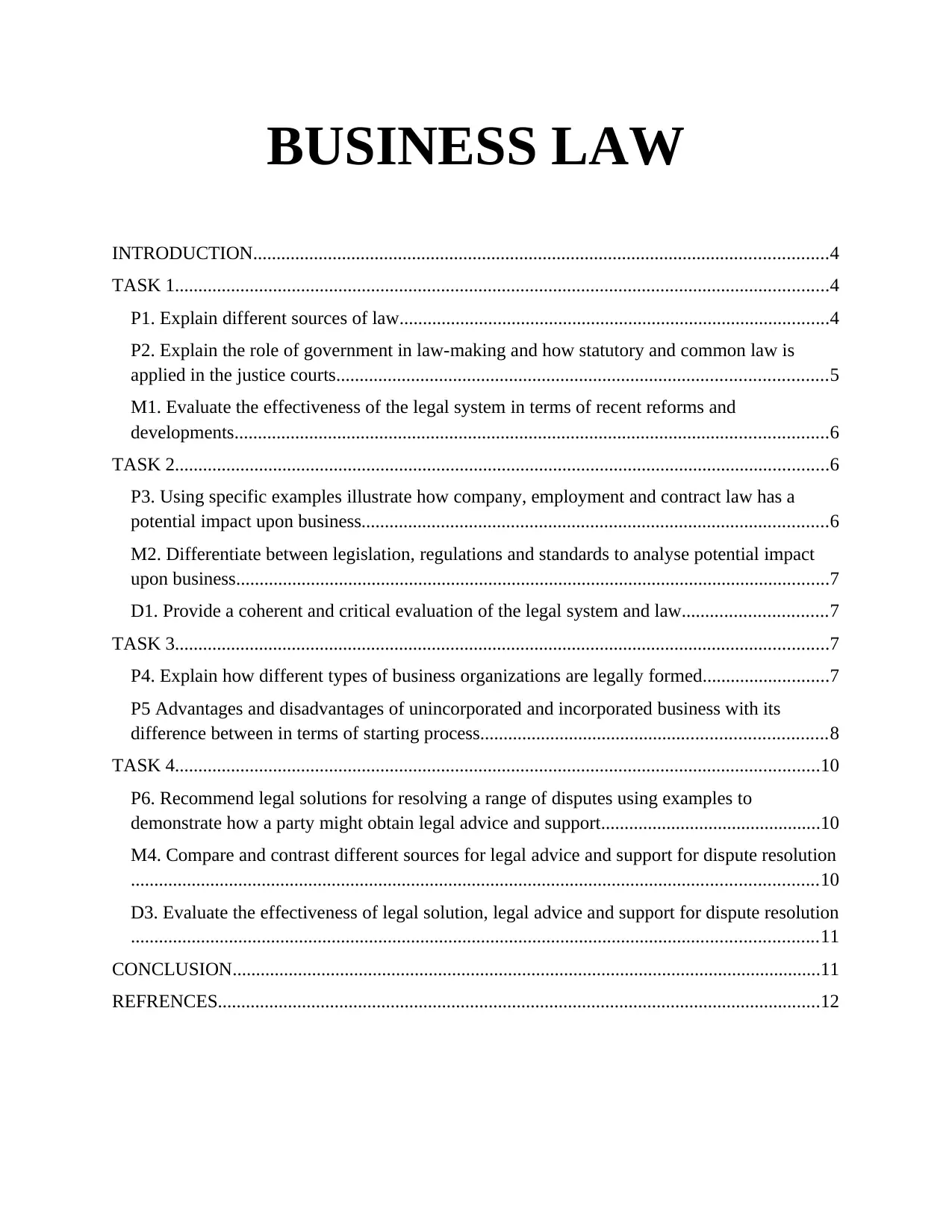
BUSINESS LAW
INTRODUCTION...........................................................................................................................4
TASK 1............................................................................................................................................4
P1. Explain different sources of law............................................................................................4
P2. Explain the role of government in law-making and how statutory and common law is
applied in the justice courts.........................................................................................................5
M1. Evaluate the effectiveness of the legal system in terms of recent reforms and
developments...............................................................................................................................6
TASK 2............................................................................................................................................6
P3. Using specific examples illustrate how company, employment and contract law has a
potential impact upon business....................................................................................................6
M2. Differentiate between legislation, regulations and standards to analyse potential impact
upon business...............................................................................................................................7
D1. Provide a coherent and critical evaluation of the legal system and law...............................7
TASK 3............................................................................................................................................7
P4. Explain how different types of business organizations are legally formed...........................7
P5 Advantages and disadvantages of unincorporated and incorporated business with its
difference between in terms of starting process..........................................................................8
TASK 4..........................................................................................................................................10
P6. Recommend legal solutions for resolving a range of disputes using examples to
demonstrate how a party might obtain legal advice and support...............................................10
M4. Compare and contrast different sources for legal advice and support for dispute resolution
...................................................................................................................................................10
D3. Evaluate the effectiveness of legal solution, legal advice and support for dispute resolution
...................................................................................................................................................11
CONCLUSION..............................................................................................................................11
REFRENCES.................................................................................................................................12
INTRODUCTION...........................................................................................................................4
TASK 1............................................................................................................................................4
P1. Explain different sources of law............................................................................................4
P2. Explain the role of government in law-making and how statutory and common law is
applied in the justice courts.........................................................................................................5
M1. Evaluate the effectiveness of the legal system in terms of recent reforms and
developments...............................................................................................................................6
TASK 2............................................................................................................................................6
P3. Using specific examples illustrate how company, employment and contract law has a
potential impact upon business....................................................................................................6
M2. Differentiate between legislation, regulations and standards to analyse potential impact
upon business...............................................................................................................................7
D1. Provide a coherent and critical evaluation of the legal system and law...............................7
TASK 3............................................................................................................................................7
P4. Explain how different types of business organizations are legally formed...........................7
P5 Advantages and disadvantages of unincorporated and incorporated business with its
difference between in terms of starting process..........................................................................8
TASK 4..........................................................................................................................................10
P6. Recommend legal solutions for resolving a range of disputes using examples to
demonstrate how a party might obtain legal advice and support...............................................10
M4. Compare and contrast different sources for legal advice and support for dispute resolution
...................................................................................................................................................10
D3. Evaluate the effectiveness of legal solution, legal advice and support for dispute resolution
...................................................................................................................................................11
CONCLUSION..............................................................................................................................11
REFRENCES.................................................................................................................................12
Paraphrase This Document
Need a fresh take? Get an instant paraphrase of this document with our AI Paraphraser
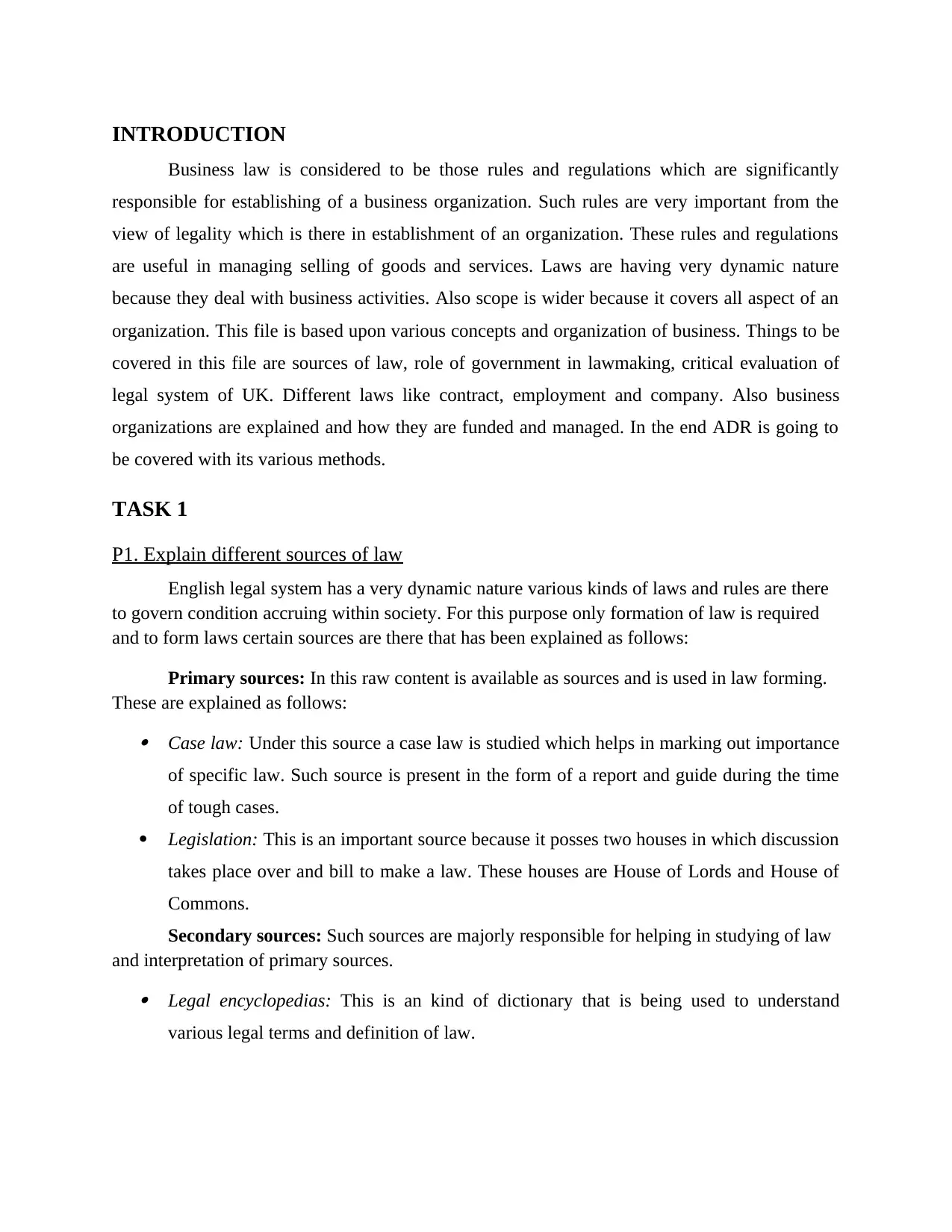
INTRODUCTION
Business law is considered to be those rules and regulations which are significantly
responsible for establishing of a business organization. Such rules are very important from the
view of legality which is there in establishment of an organization. These rules and regulations
are useful in managing selling of goods and services. Laws are having very dynamic nature
because they deal with business activities. Also scope is wider because it covers all aspect of an
organization. This file is based upon various concepts and organization of business. Things to be
covered in this file are sources of law, role of government in lawmaking, critical evaluation of
legal system of UK. Different laws like contract, employment and company. Also business
organizations are explained and how they are funded and managed. In the end ADR is going to
be covered with its various methods.
TASK 1
P1. Explain different sources of law
English legal system has a very dynamic nature various kinds of laws and rules are there
to govern condition accruing within society. For this purpose only formation of law is required
and to form laws certain sources are there that has been explained as follows:
Primary sources: In this raw content is available as sources and is used in law forming.
These are explained as follows: Case law: Under this source a case law is studied which helps in marking out importance
of specific law. Such source is present in the form of a report and guide during the time
of tough cases.
Legislation: This is an important source because it posses two houses in which discussion
takes place over and bill to make a law. These houses are House of Lords and House of
Commons.
Secondary sources: Such sources are majorly responsible for helping in studying of law
and interpretation of primary sources. Legal encyclopedias: This is an kind of dictionary that is being used to understand
various legal terms and definition of law.
Business law is considered to be those rules and regulations which are significantly
responsible for establishing of a business organization. Such rules are very important from the
view of legality which is there in establishment of an organization. These rules and regulations
are useful in managing selling of goods and services. Laws are having very dynamic nature
because they deal with business activities. Also scope is wider because it covers all aspect of an
organization. This file is based upon various concepts and organization of business. Things to be
covered in this file are sources of law, role of government in lawmaking, critical evaluation of
legal system of UK. Different laws like contract, employment and company. Also business
organizations are explained and how they are funded and managed. In the end ADR is going to
be covered with its various methods.
TASK 1
P1. Explain different sources of law
English legal system has a very dynamic nature various kinds of laws and rules are there
to govern condition accruing within society. For this purpose only formation of law is required
and to form laws certain sources are there that has been explained as follows:
Primary sources: In this raw content is available as sources and is used in law forming.
These are explained as follows: Case law: Under this source a case law is studied which helps in marking out importance
of specific law. Such source is present in the form of a report and guide during the time
of tough cases.
Legislation: This is an important source because it posses two houses in which discussion
takes place over and bill to make a law. These houses are House of Lords and House of
Commons.
Secondary sources: Such sources are majorly responsible for helping in studying of law
and interpretation of primary sources. Legal encyclopedias: This is an kind of dictionary that is being used to understand
various legal terms and definition of law.
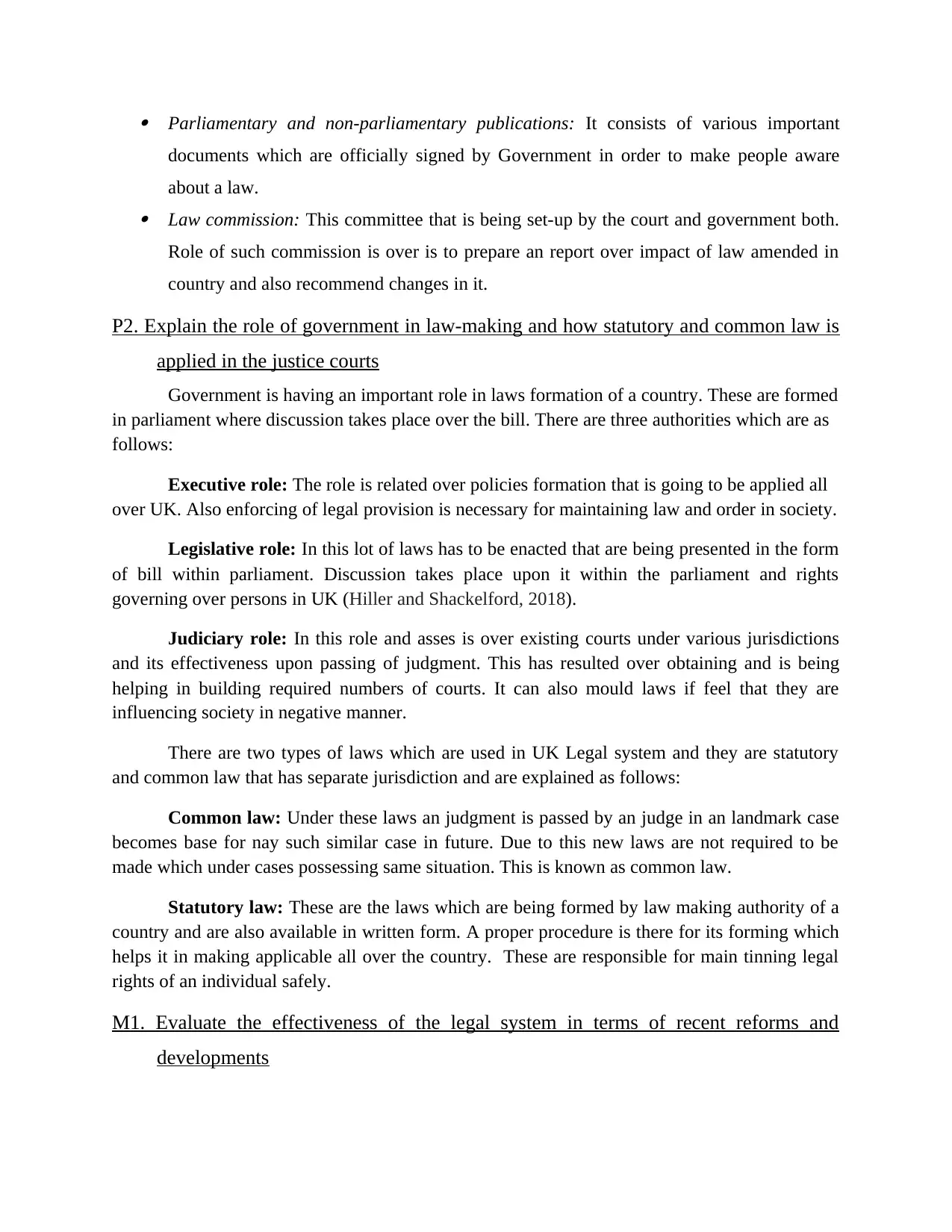
Parliamentary and non-parliamentary publications: It consists of various important
documents which are officially signed by Government in order to make people aware
about a law. Law commission: This committee that is being set-up by the court and government both.
Role of such commission is over is to prepare an report over impact of law amended in
country and also recommend changes in it.
P2. Explain the role of government in law-making and how statutory and common law is
applied in the justice courts
Government is having an important role in laws formation of a country. These are formed
in parliament where discussion takes place over the bill. There are three authorities which are as
follows:
Executive role: The role is related over policies formation that is going to be applied all
over UK. Also enforcing of legal provision is necessary for maintaining law and order in society.
Legislative role: In this lot of laws has to be enacted that are being presented in the form
of bill within parliament. Discussion takes place upon it within the parliament and rights
governing over persons in UK (Hiller and Shackelford, 2018).
Judiciary role: In this role and asses is over existing courts under various jurisdictions
and its effectiveness upon passing of judgment. This has resulted over obtaining and is being
helping in building required numbers of courts. It can also mould laws if feel that they are
influencing society in negative manner.
There are two types of laws which are used in UK Legal system and they are statutory
and common law that has separate jurisdiction and are explained as follows:
Common law: Under these laws an judgment is passed by an judge in an landmark case
becomes base for nay such similar case in future. Due to this new laws are not required to be
made which under cases possessing same situation. This is known as common law.
Statutory law: These are the laws which are being formed by law making authority of a
country and are also available in written form. A proper procedure is there for its forming which
helps it in making applicable all over the country. These are responsible for main tinning legal
rights of an individual safely.
M1. Evaluate the effectiveness of the legal system in terms of recent reforms and
developments
documents which are officially signed by Government in order to make people aware
about a law. Law commission: This committee that is being set-up by the court and government both.
Role of such commission is over is to prepare an report over impact of law amended in
country and also recommend changes in it.
P2. Explain the role of government in law-making and how statutory and common law is
applied in the justice courts
Government is having an important role in laws formation of a country. These are formed
in parliament where discussion takes place over the bill. There are three authorities which are as
follows:
Executive role: The role is related over policies formation that is going to be applied all
over UK. Also enforcing of legal provision is necessary for maintaining law and order in society.
Legislative role: In this lot of laws has to be enacted that are being presented in the form
of bill within parliament. Discussion takes place upon it within the parliament and rights
governing over persons in UK (Hiller and Shackelford, 2018).
Judiciary role: In this role and asses is over existing courts under various jurisdictions
and its effectiveness upon passing of judgment. This has resulted over obtaining and is being
helping in building required numbers of courts. It can also mould laws if feel that they are
influencing society in negative manner.
There are two types of laws which are used in UK Legal system and they are statutory
and common law that has separate jurisdiction and are explained as follows:
Common law: Under these laws an judgment is passed by an judge in an landmark case
becomes base for nay such similar case in future. Due to this new laws are not required to be
made which under cases possessing same situation. This is known as common law.
Statutory law: These are the laws which are being formed by law making authority of a
country and are also available in written form. A proper procedure is there for its forming which
helps it in making applicable all over the country. These are responsible for main tinning legal
rights of an individual safely.
M1. Evaluate the effectiveness of the legal system in terms of recent reforms and
developments
⊘ This is a preview!⊘
Do you want full access?
Subscribe today to unlock all pages.

Trusted by 1+ million students worldwide
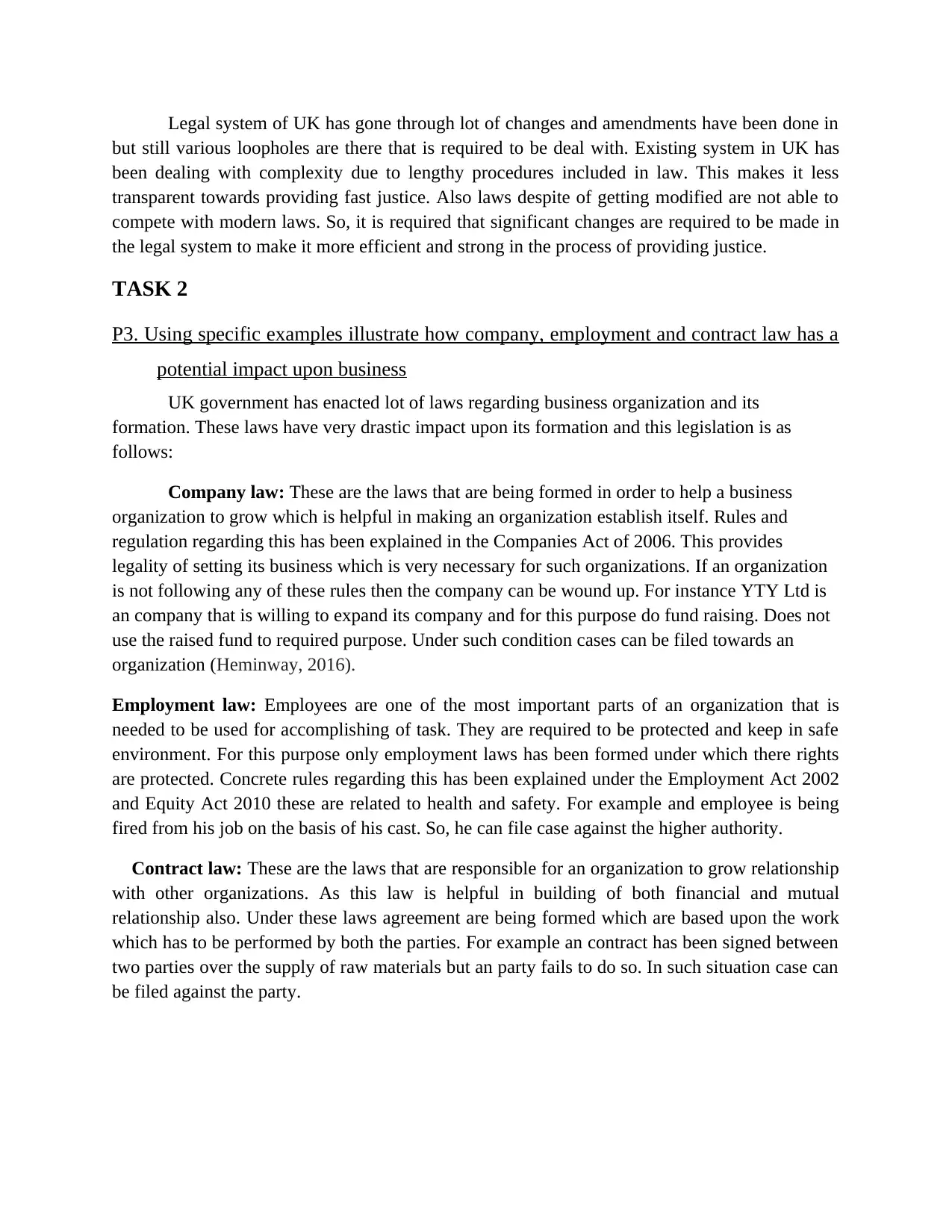
Legal system of UK has gone through lot of changes and amendments have been done in
but still various loopholes are there that is required to be deal with. Existing system in UK has
been dealing with complexity due to lengthy procedures included in law. This makes it less
transparent towards providing fast justice. Also laws despite of getting modified are not able to
compete with modern laws. So, it is required that significant changes are required to be made in
the legal system to make it more efficient and strong in the process of providing justice.
TASK 2
P3. Using specific examples illustrate how company, employment and contract law has a
potential impact upon business
UK government has enacted lot of laws regarding business organization and its
formation. These laws have very drastic impact upon its formation and this legislation is as
follows:
Company law: These are the laws that are being formed in order to help a business
organization to grow which is helpful in making an organization establish itself. Rules and
regulation regarding this has been explained in the Companies Act of 2006. This provides
legality of setting its business which is very necessary for such organizations. If an organization
is not following any of these rules then the company can be wound up. For instance YTY Ltd is
an company that is willing to expand its company and for this purpose do fund raising. Does not
use the raised fund to required purpose. Under such condition cases can be filed towards an
organization (Heminway, 2016).
Employment law: Employees are one of the most important parts of an organization that is
needed to be used for accomplishing of task. They are required to be protected and keep in safe
environment. For this purpose only employment laws has been formed under which there rights
are protected. Concrete rules regarding this has been explained under the Employment Act 2002
and Equity Act 2010 these are related to health and safety. For example and employee is being
fired from his job on the basis of his cast. So, he can file case against the higher authority.
Contract law: These are the laws that are responsible for an organization to grow relationship
with other organizations. As this law is helpful in building of both financial and mutual
relationship also. Under these laws agreement are being formed which are based upon the work
which has to be performed by both the parties. For example an contract has been signed between
two parties over the supply of raw materials but an party fails to do so. In such situation case can
be filed against the party.
but still various loopholes are there that is required to be deal with. Existing system in UK has
been dealing with complexity due to lengthy procedures included in law. This makes it less
transparent towards providing fast justice. Also laws despite of getting modified are not able to
compete with modern laws. So, it is required that significant changes are required to be made in
the legal system to make it more efficient and strong in the process of providing justice.
TASK 2
P3. Using specific examples illustrate how company, employment and contract law has a
potential impact upon business
UK government has enacted lot of laws regarding business organization and its
formation. These laws have very drastic impact upon its formation and this legislation is as
follows:
Company law: These are the laws that are being formed in order to help a business
organization to grow which is helpful in making an organization establish itself. Rules and
regulation regarding this has been explained in the Companies Act of 2006. This provides
legality of setting its business which is very necessary for such organizations. If an organization
is not following any of these rules then the company can be wound up. For instance YTY Ltd is
an company that is willing to expand its company and for this purpose do fund raising. Does not
use the raised fund to required purpose. Under such condition cases can be filed towards an
organization (Heminway, 2016).
Employment law: Employees are one of the most important parts of an organization that is
needed to be used for accomplishing of task. They are required to be protected and keep in safe
environment. For this purpose only employment laws has been formed under which there rights
are protected. Concrete rules regarding this has been explained under the Employment Act 2002
and Equity Act 2010 these are related to health and safety. For example and employee is being
fired from his job on the basis of his cast. So, he can file case against the higher authority.
Contract law: These are the laws that are responsible for an organization to grow relationship
with other organizations. As this law is helpful in building of both financial and mutual
relationship also. Under these laws agreement are being formed which are based upon the work
which has to be performed by both the parties. For example an contract has been signed between
two parties over the supply of raw materials but an party fails to do so. In such situation case can
be filed against the party.
Paraphrase This Document
Need a fresh take? Get an instant paraphrase of this document with our AI Paraphraser
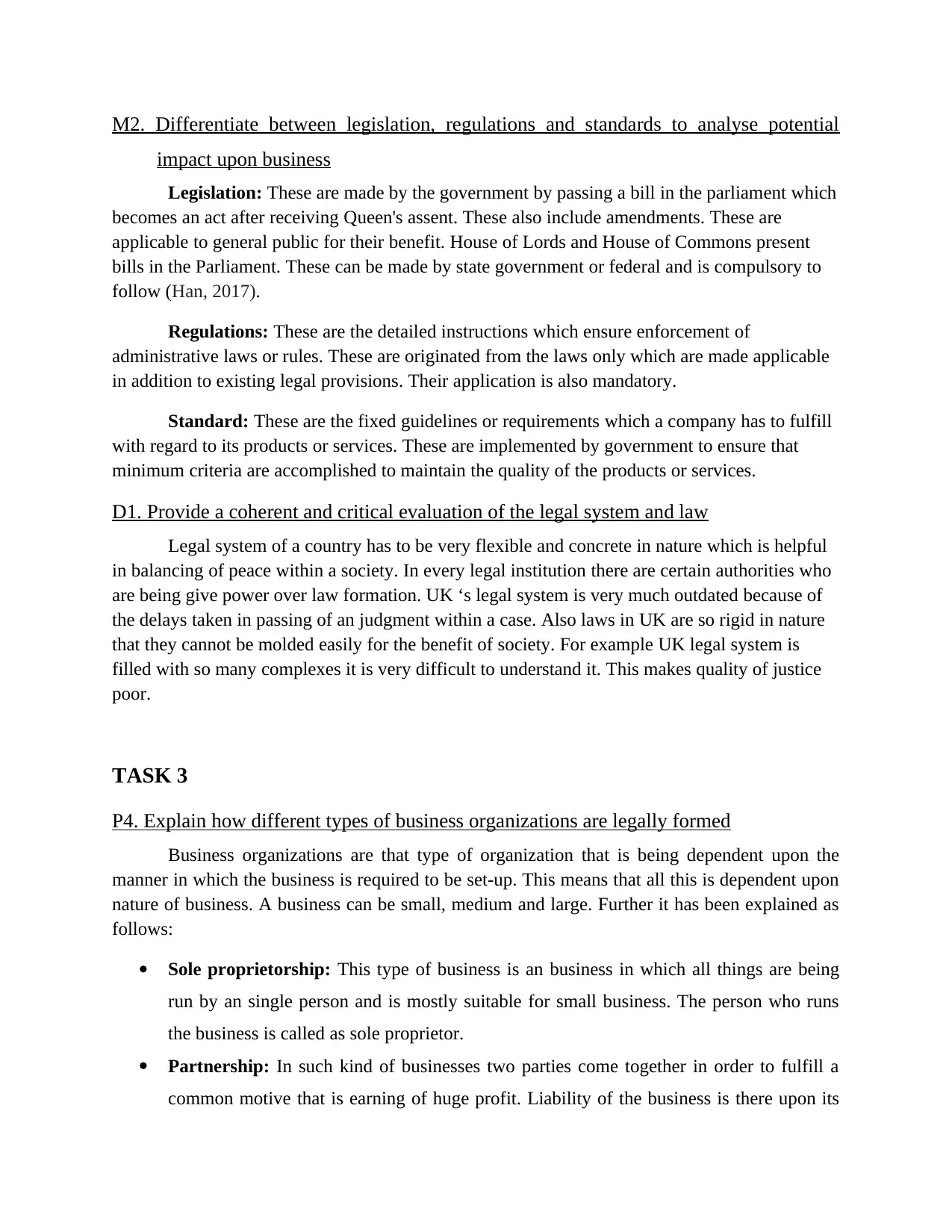
M2. Differentiate between legislation, regulations and standards to analyse potential
impact upon business
Legislation: These are made by the government by passing a bill in the parliament which
becomes an act after receiving Queen's assent. These also include amendments. These are
applicable to general public for their benefit. House of Lords and House of Commons present
bills in the Parliament. These can be made by state government or federal and is compulsory to
follow (Han, 2017).
Regulations: These are the detailed instructions which ensure enforcement of
administrative laws or rules. These are originated from the laws only which are made applicable
in addition to existing legal provisions. Their application is also mandatory.
Standard: These are the fixed guidelines or requirements which a company has to fulfill
with regard to its products or services. These are implemented by government to ensure that
minimum criteria are accomplished to maintain the quality of the products or services.
D1. Provide a coherent and critical evaluation of the legal system and law
Legal system of a country has to be very flexible and concrete in nature which is helpful
in balancing of peace within a society. In every legal institution there are certain authorities who
are being give power over law formation. UK ‘s legal system is very much outdated because of
the delays taken in passing of an judgment within a case. Also laws in UK are so rigid in nature
that they cannot be molded easily for the benefit of society. For example UK legal system is
filled with so many complexes it is very difficult to understand it. This makes quality of justice
poor.
TASK 3
P4. Explain how different types of business organizations are legally formed
Business organizations are that type of organization that is being dependent upon the
manner in which the business is required to be set-up. This means that all this is dependent upon
nature of business. A business can be small, medium and large. Further it has been explained as
follows:
Sole proprietorship: This type of business is an business in which all things are being
run by an single person and is mostly suitable for small business. The person who runs
the business is called as sole proprietor.
Partnership: In such kind of businesses two parties come together in order to fulfill a
common motive that is earning of huge profit. Liability of the business is there upon its
impact upon business
Legislation: These are made by the government by passing a bill in the parliament which
becomes an act after receiving Queen's assent. These also include amendments. These are
applicable to general public for their benefit. House of Lords and House of Commons present
bills in the Parliament. These can be made by state government or federal and is compulsory to
follow (Han, 2017).
Regulations: These are the detailed instructions which ensure enforcement of
administrative laws or rules. These are originated from the laws only which are made applicable
in addition to existing legal provisions. Their application is also mandatory.
Standard: These are the fixed guidelines or requirements which a company has to fulfill
with regard to its products or services. These are implemented by government to ensure that
minimum criteria are accomplished to maintain the quality of the products or services.
D1. Provide a coherent and critical evaluation of the legal system and law
Legal system of a country has to be very flexible and concrete in nature which is helpful
in balancing of peace within a society. In every legal institution there are certain authorities who
are being give power over law formation. UK ‘s legal system is very much outdated because of
the delays taken in passing of an judgment within a case. Also laws in UK are so rigid in nature
that they cannot be molded easily for the benefit of society. For example UK legal system is
filled with so many complexes it is very difficult to understand it. This makes quality of justice
poor.
TASK 3
P4. Explain how different types of business organizations are legally formed
Business organizations are that type of organization that is being dependent upon the
manner in which the business is required to be set-up. This means that all this is dependent upon
nature of business. A business can be small, medium and large. Further it has been explained as
follows:
Sole proprietorship: This type of business is an business in which all things are being
run by an single person and is mostly suitable for small business. The person who runs
the business is called as sole proprietor.
Partnership: In such kind of businesses two parties come together in order to fulfill a
common motive that is earning of huge profit. Liability of the business is there upon its
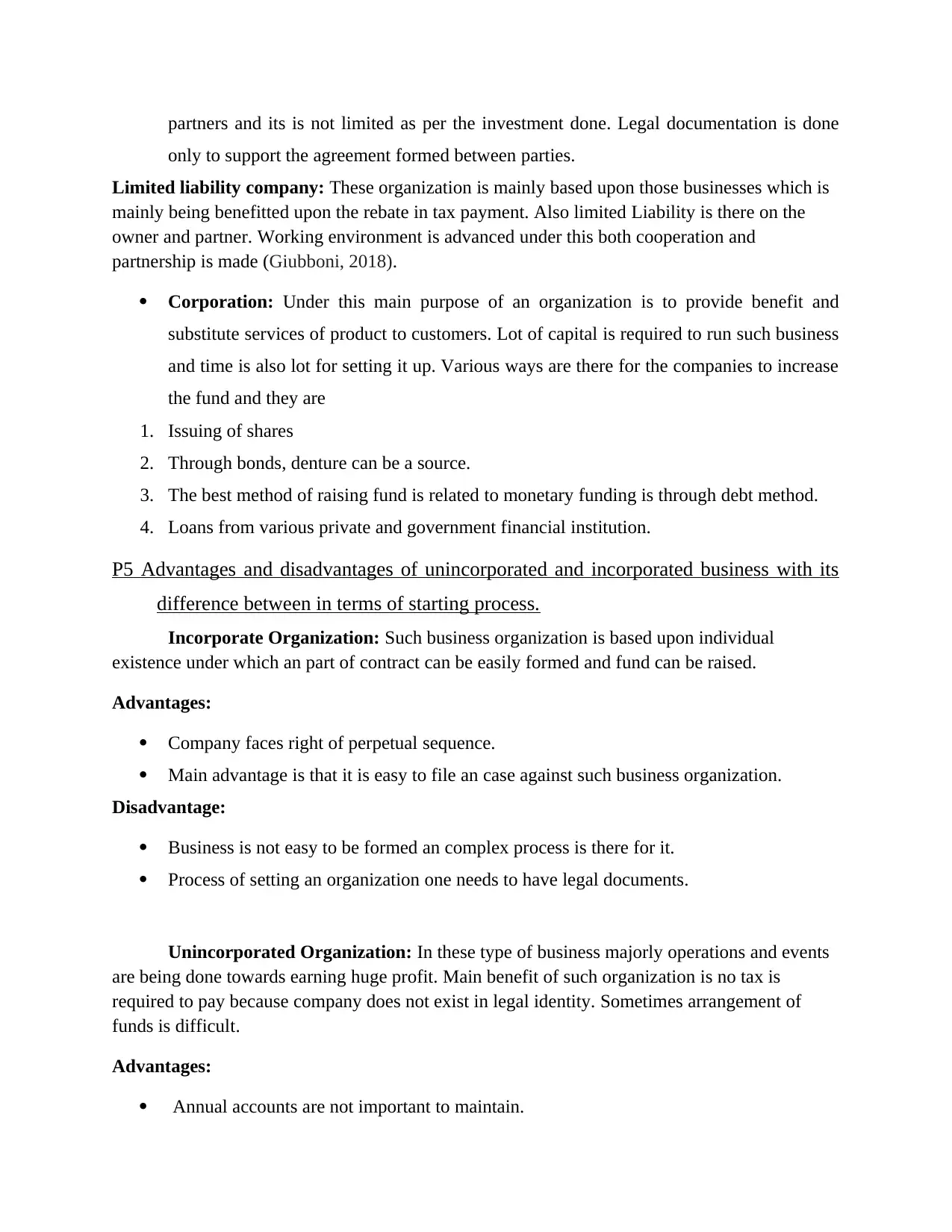
partners and its is not limited as per the investment done. Legal documentation is done
only to support the agreement formed between parties.
Limited liability company: These organization is mainly based upon those businesses which is
mainly being benefitted upon the rebate in tax payment. Also limited Liability is there on the
owner and partner. Working environment is advanced under this both cooperation and
partnership is made (Giubboni, 2018).
Corporation: Under this main purpose of an organization is to provide benefit and
substitute services of product to customers. Lot of capital is required to run such business
and time is also lot for setting it up. Various ways are there for the companies to increase
the fund and they are
1. Issuing of shares
2. Through bonds, denture can be a source.
3. The best method of raising fund is related to monetary funding is through debt method.
4. Loans from various private and government financial institution.
P5 Advantages and disadvantages of unincorporated and incorporated business with its
difference between in terms of starting process.
Incorporate Organization: Such business organization is based upon individual
existence under which an part of contract can be easily formed and fund can be raised.
Advantages:
Company faces right of perpetual sequence.
Main advantage is that it is easy to file an case against such business organization.
Disadvantage:
Business is not easy to be formed an complex process is there for it.
Process of setting an organization one needs to have legal documents.
Unincorporated Organization: In these type of business majorly operations and events
are being done towards earning huge profit. Main benefit of such organization is no tax is
required to pay because company does not exist in legal identity. Sometimes arrangement of
funds is difficult.
Advantages:
Annual accounts are not important to maintain.
only to support the agreement formed between parties.
Limited liability company: These organization is mainly based upon those businesses which is
mainly being benefitted upon the rebate in tax payment. Also limited Liability is there on the
owner and partner. Working environment is advanced under this both cooperation and
partnership is made (Giubboni, 2018).
Corporation: Under this main purpose of an organization is to provide benefit and
substitute services of product to customers. Lot of capital is required to run such business
and time is also lot for setting it up. Various ways are there for the companies to increase
the fund and they are
1. Issuing of shares
2. Through bonds, denture can be a source.
3. The best method of raising fund is related to monetary funding is through debt method.
4. Loans from various private and government financial institution.
P5 Advantages and disadvantages of unincorporated and incorporated business with its
difference between in terms of starting process.
Incorporate Organization: Such business organization is based upon individual
existence under which an part of contract can be easily formed and fund can be raised.
Advantages:
Company faces right of perpetual sequence.
Main advantage is that it is easy to file an case against such business organization.
Disadvantage:
Business is not easy to be formed an complex process is there for it.
Process of setting an organization one needs to have legal documents.
Unincorporated Organization: In these type of business majorly operations and events
are being done towards earning huge profit. Main benefit of such organization is no tax is
required to pay because company does not exist in legal identity. Sometimes arrangement of
funds is difficult.
Advantages:
Annual accounts are not important to maintain.
⊘ This is a preview!⊘
Do you want full access?
Subscribe today to unlock all pages.

Trusted by 1+ million students worldwide
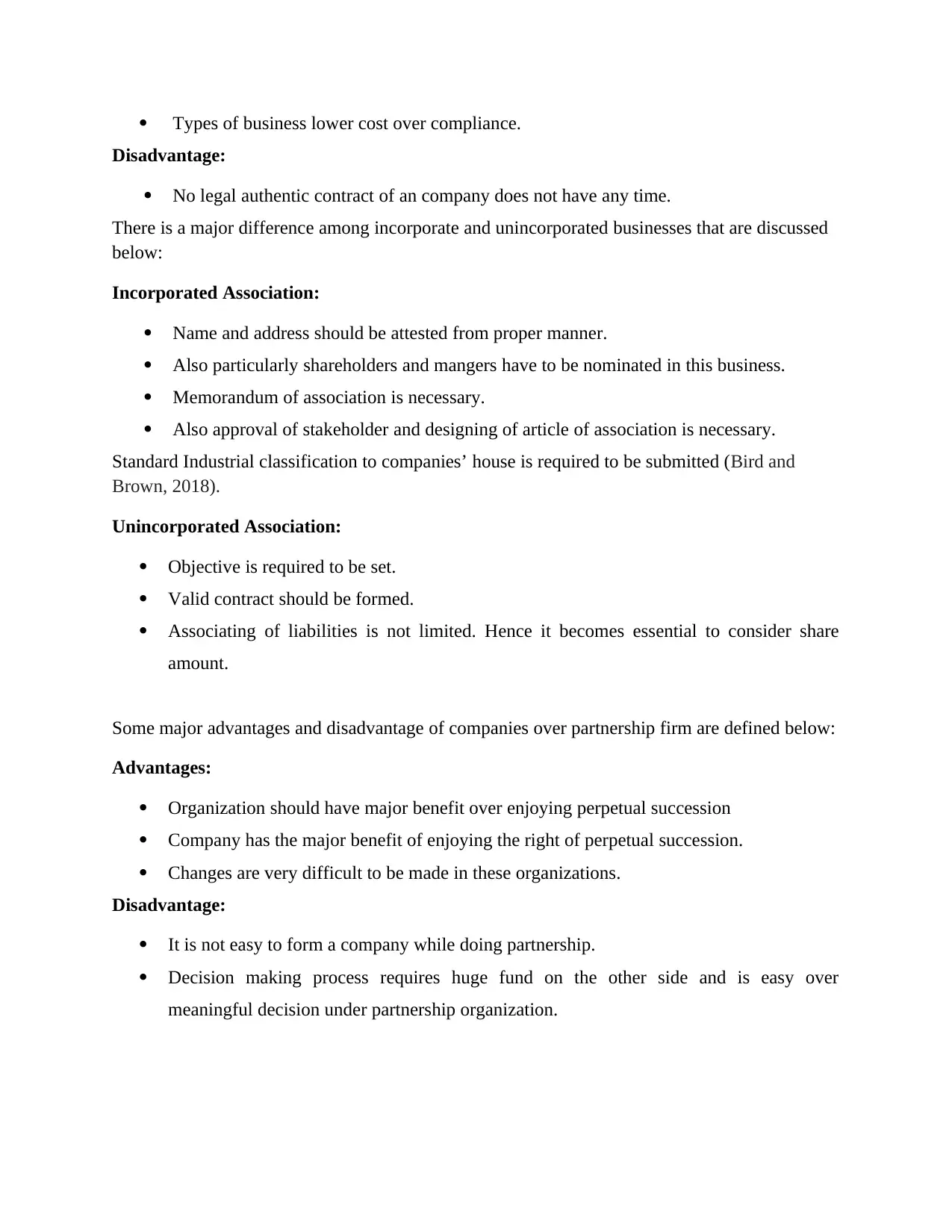
Types of business lower cost over compliance.
Disadvantage:
No legal authentic contract of an company does not have any time.
There is a major difference among incorporate and unincorporated businesses that are discussed
below:
Incorporated Association:
Name and address should be attested from proper manner.
Also particularly shareholders and mangers have to be nominated in this business.
Memorandum of association is necessary.
Also approval of stakeholder and designing of article of association is necessary.
Standard Industrial classification to companies’ house is required to be submitted (Bird and
Brown, 2018).
Unincorporated Association:
Objective is required to be set.
Valid contract should be formed.
Associating of liabilities is not limited. Hence it becomes essential to consider share
amount.
Some major advantages and disadvantage of companies over partnership firm are defined below:
Advantages:
Organization should have major benefit over enjoying perpetual succession
Company has the major benefit of enjoying the right of perpetual succession.
Changes are very difficult to be made in these organizations.
Disadvantage:
It is not easy to form a company while doing partnership.
Decision making process requires huge fund on the other side and is easy over
meaningful decision under partnership organization.
Disadvantage:
No legal authentic contract of an company does not have any time.
There is a major difference among incorporate and unincorporated businesses that are discussed
below:
Incorporated Association:
Name and address should be attested from proper manner.
Also particularly shareholders and mangers have to be nominated in this business.
Memorandum of association is necessary.
Also approval of stakeholder and designing of article of association is necessary.
Standard Industrial classification to companies’ house is required to be submitted (Bird and
Brown, 2018).
Unincorporated Association:
Objective is required to be set.
Valid contract should be formed.
Associating of liabilities is not limited. Hence it becomes essential to consider share
amount.
Some major advantages and disadvantage of companies over partnership firm are defined below:
Advantages:
Organization should have major benefit over enjoying perpetual succession
Company has the major benefit of enjoying the right of perpetual succession.
Changes are very difficult to be made in these organizations.
Disadvantage:
It is not easy to form a company while doing partnership.
Decision making process requires huge fund on the other side and is easy over
meaningful decision under partnership organization.
Paraphrase This Document
Need a fresh take? Get an instant paraphrase of this document with our AI Paraphraser
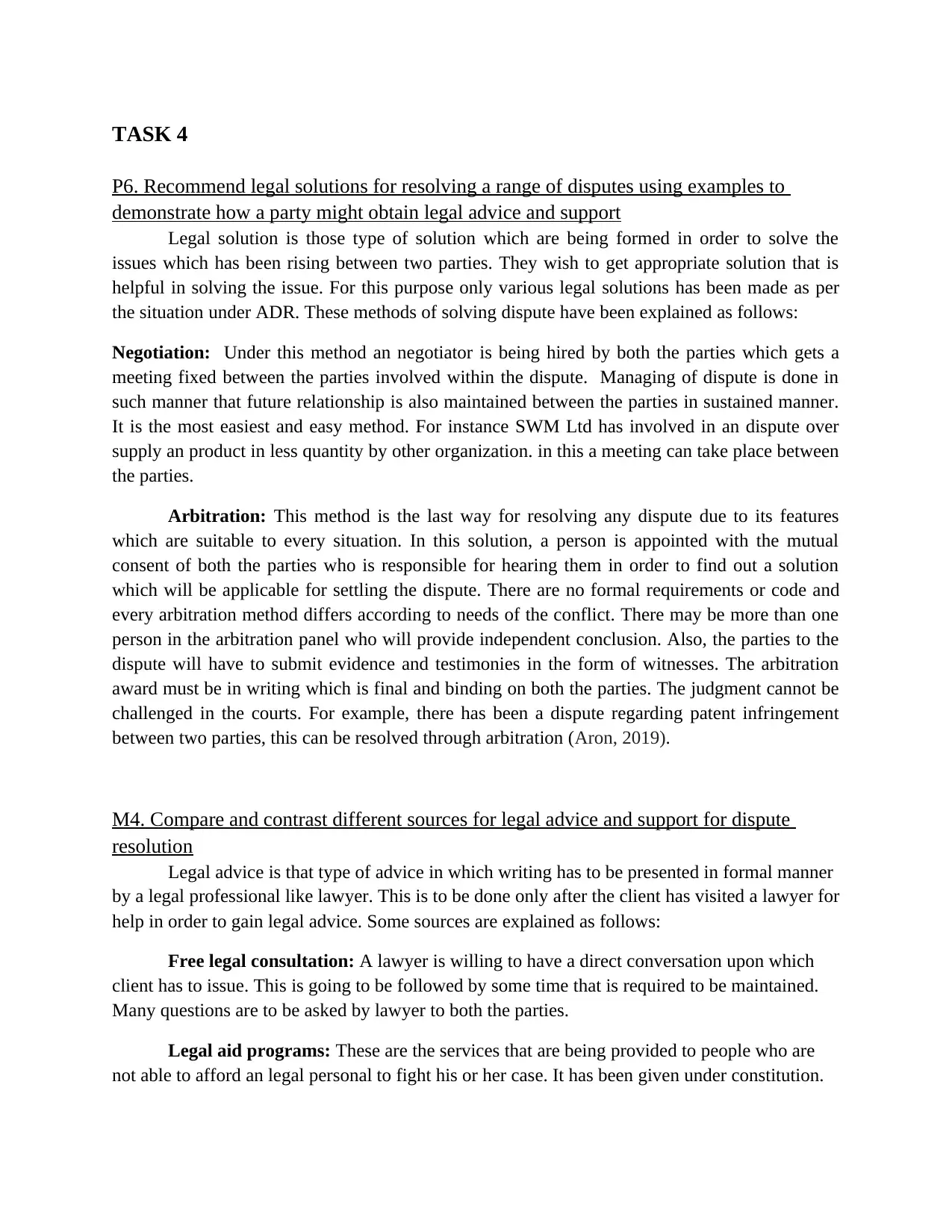
TASK 4
P6. Recommend legal solutions for resolving a range of disputes using examples to
demonstrate how a party might obtain legal advice and support
Legal solution is those type of solution which are being formed in order to solve the
issues which has been rising between two parties. They wish to get appropriate solution that is
helpful in solving the issue. For this purpose only various legal solutions has been made as per
the situation under ADR. These methods of solving dispute have been explained as follows:
Negotiation: Under this method an negotiator is being hired by both the parties which gets a
meeting fixed between the parties involved within the dispute. Managing of dispute is done in
such manner that future relationship is also maintained between the parties in sustained manner.
It is the most easiest and easy method. For instance SWM Ltd has involved in an dispute over
supply an product in less quantity by other organization. in this a meeting can take place between
the parties.
Arbitration: This method is the last way for resolving any dispute due to its features
which are suitable to every situation. In this solution, a person is appointed with the mutual
consent of both the parties who is responsible for hearing them in order to find out a solution
which will be applicable for settling the dispute. There are no formal requirements or code and
every arbitration method differs according to needs of the conflict. There may be more than one
person in the arbitration panel who will provide independent conclusion. Also, the parties to the
dispute will have to submit evidence and testimonies in the form of witnesses. The arbitration
award must be in writing which is final and binding on both the parties. The judgment cannot be
challenged in the courts. For example, there has been a dispute regarding patent infringement
between two parties, this can be resolved through arbitration (Aron, 2019).
M4. Compare and contrast different sources for legal advice and support for dispute
resolution
Legal advice is that type of advice in which writing has to be presented in formal manner
by a legal professional like lawyer. This is to be done only after the client has visited a lawyer for
help in order to gain legal advice. Some sources are explained as follows:
Free legal consultation: A lawyer is willing to have a direct conversation upon which
client has to issue. This is going to be followed by some time that is required to be maintained.
Many questions are to be asked by lawyer to both the parties.
Legal aid programs: These are the services that are being provided to people who are
not able to afford an legal personal to fight his or her case. It has been given under constitution.
P6. Recommend legal solutions for resolving a range of disputes using examples to
demonstrate how a party might obtain legal advice and support
Legal solution is those type of solution which are being formed in order to solve the
issues which has been rising between two parties. They wish to get appropriate solution that is
helpful in solving the issue. For this purpose only various legal solutions has been made as per
the situation under ADR. These methods of solving dispute have been explained as follows:
Negotiation: Under this method an negotiator is being hired by both the parties which gets a
meeting fixed between the parties involved within the dispute. Managing of dispute is done in
such manner that future relationship is also maintained between the parties in sustained manner.
It is the most easiest and easy method. For instance SWM Ltd has involved in an dispute over
supply an product in less quantity by other organization. in this a meeting can take place between
the parties.
Arbitration: This method is the last way for resolving any dispute due to its features
which are suitable to every situation. In this solution, a person is appointed with the mutual
consent of both the parties who is responsible for hearing them in order to find out a solution
which will be applicable for settling the dispute. There are no formal requirements or code and
every arbitration method differs according to needs of the conflict. There may be more than one
person in the arbitration panel who will provide independent conclusion. Also, the parties to the
dispute will have to submit evidence and testimonies in the form of witnesses. The arbitration
award must be in writing which is final and binding on both the parties. The judgment cannot be
challenged in the courts. For example, there has been a dispute regarding patent infringement
between two parties, this can be resolved through arbitration (Aron, 2019).
M4. Compare and contrast different sources for legal advice and support for dispute
resolution
Legal advice is that type of advice in which writing has to be presented in formal manner
by a legal professional like lawyer. This is to be done only after the client has visited a lawyer for
help in order to gain legal advice. Some sources are explained as follows:
Free legal consultation: A lawyer is willing to have a direct conversation upon which
client has to issue. This is going to be followed by some time that is required to be maintained.
Many questions are to be asked by lawyer to both the parties.
Legal aid programs: These are the services that are being provided to people who are
not able to afford an legal personal to fight his or her case. It has been given under constitution.
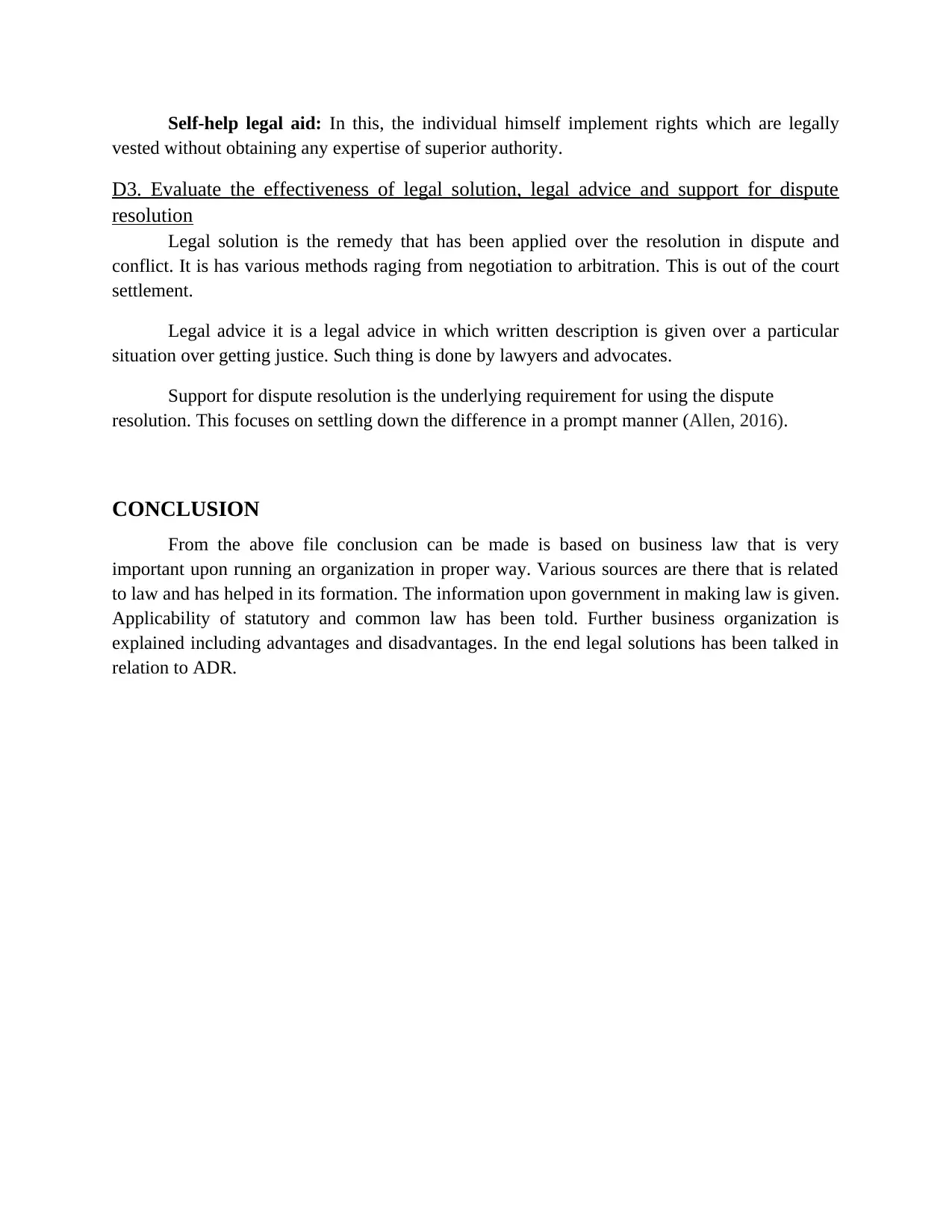
Self-help legal aid: In this, the individual himself implement rights which are legally
vested without obtaining any expertise of superior authority.
D3. Evaluate the effectiveness of legal solution, legal advice and support for dispute
resolution
Legal solution is the remedy that has been applied over the resolution in dispute and
conflict. It is has various methods raging from negotiation to arbitration. This is out of the court
settlement.
Legal advice it is a legal advice in which written description is given over a particular
situation over getting justice. Such thing is done by lawyers and advocates.
Support for dispute resolution is the underlying requirement for using the dispute
resolution. This focuses on settling down the difference in a prompt manner (Allen, 2016).
CONCLUSION
From the above file conclusion can be made is based on business law that is very
important upon running an organization in proper way. Various sources are there that is related
to law and has helped in its formation. The information upon government in making law is given.
Applicability of statutory and common law has been told. Further business organization is
explained including advantages and disadvantages. In the end legal solutions has been talked in
relation to ADR.
vested without obtaining any expertise of superior authority.
D3. Evaluate the effectiveness of legal solution, legal advice and support for dispute
resolution
Legal solution is the remedy that has been applied over the resolution in dispute and
conflict. It is has various methods raging from negotiation to arbitration. This is out of the court
settlement.
Legal advice it is a legal advice in which written description is given over a particular
situation over getting justice. Such thing is done by lawyers and advocates.
Support for dispute resolution is the underlying requirement for using the dispute
resolution. This focuses on settling down the difference in a prompt manner (Allen, 2016).
CONCLUSION
From the above file conclusion can be made is based on business law that is very
important upon running an organization in proper way. Various sources are there that is related
to law and has helped in its formation. The information upon government in making law is given.
Applicability of statutory and common law has been told. Further business organization is
explained including advantages and disadvantages. In the end legal solutions has been talked in
relation to ADR.
⊘ This is a preview!⊘
Do you want full access?
Subscribe today to unlock all pages.

Trusted by 1+ million students worldwide
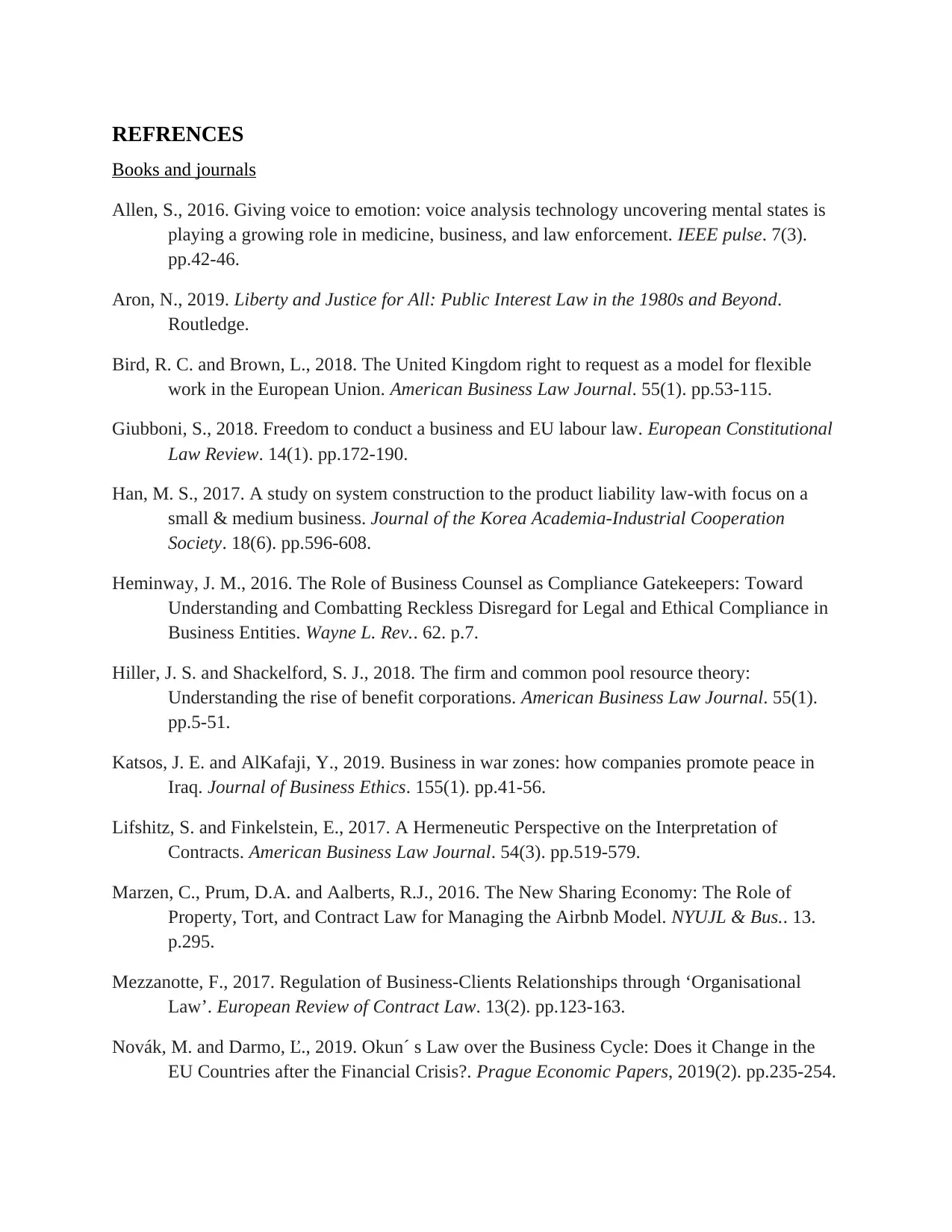
REFRENCES
Books and journals
Allen, S., 2016. Giving voice to emotion: voice analysis technology uncovering mental states is
playing a growing role in medicine, business, and law enforcement. IEEE pulse. 7(3).
pp.42-46.
Aron, N., 2019. Liberty and Justice for All: Public Interest Law in the 1980s and Beyond.
Routledge.
Bird, R. C. and Brown, L., 2018. The United Kingdom right to request as a model for flexible
work in the European Union. American Business Law Journal. 55(1). pp.53-115.
Giubboni, S., 2018. Freedom to conduct a business and EU labour law. European Constitutional
Law Review. 14(1). pp.172-190.
Han, M. S., 2017. A study on system construction to the product liability law-with focus on a
small & medium business. Journal of the Korea Academia-Industrial Cooperation
Society. 18(6). pp.596-608.
Heminway, J. M., 2016. The Role of Business Counsel as Compliance Gatekeepers: Toward
Understanding and Combatting Reckless Disregard for Legal and Ethical Compliance in
Business Entities. Wayne L. Rev.. 62. p.7.
Hiller, J. S. and Shackelford, S. J., 2018. The firm and common pool resource theory:
Understanding the rise of benefit corporations. American Business Law Journal. 55(1).
pp.5-51.
Katsos, J. E. and AlKafaji, Y., 2019. Business in war zones: how companies promote peace in
Iraq. Journal of Business Ethics. 155(1). pp.41-56.
Lifshitz, S. and Finkelstein, E., 2017. A Hermeneutic Perspective on the Interpretation of
Contracts. American Business Law Journal. 54(3). pp.519-579.
Marzen, C., Prum, D.A. and Aalberts, R.J., 2016. The New Sharing Economy: The Role of
Property, Tort, and Contract Law for Managing the Airbnb Model. NYUJL & Bus.. 13.
p.295.
Mezzanotte, F., 2017. Regulation of Business-Clients Relationships through ‘Organisational
Law’. European Review of Contract Law. 13(2). pp.123-163.
Novák, M. and Darmo, Ľ., 2019. Okun´ s Law over the Business Cycle: Does it Change in the
EU Countries after the Financial Crisis?. Prague Economic Papers, 2019(2). pp.235-254.
Books and journals
Allen, S., 2016. Giving voice to emotion: voice analysis technology uncovering mental states is
playing a growing role in medicine, business, and law enforcement. IEEE pulse. 7(3).
pp.42-46.
Aron, N., 2019. Liberty and Justice for All: Public Interest Law in the 1980s and Beyond.
Routledge.
Bird, R. C. and Brown, L., 2018. The United Kingdom right to request as a model for flexible
work in the European Union. American Business Law Journal. 55(1). pp.53-115.
Giubboni, S., 2018. Freedom to conduct a business and EU labour law. European Constitutional
Law Review. 14(1). pp.172-190.
Han, M. S., 2017. A study on system construction to the product liability law-with focus on a
small & medium business. Journal of the Korea Academia-Industrial Cooperation
Society. 18(6). pp.596-608.
Heminway, J. M., 2016. The Role of Business Counsel as Compliance Gatekeepers: Toward
Understanding and Combatting Reckless Disregard for Legal and Ethical Compliance in
Business Entities. Wayne L. Rev.. 62. p.7.
Hiller, J. S. and Shackelford, S. J., 2018. The firm and common pool resource theory:
Understanding the rise of benefit corporations. American Business Law Journal. 55(1).
pp.5-51.
Katsos, J. E. and AlKafaji, Y., 2019. Business in war zones: how companies promote peace in
Iraq. Journal of Business Ethics. 155(1). pp.41-56.
Lifshitz, S. and Finkelstein, E., 2017. A Hermeneutic Perspective on the Interpretation of
Contracts. American Business Law Journal. 54(3). pp.519-579.
Marzen, C., Prum, D.A. and Aalberts, R.J., 2016. The New Sharing Economy: The Role of
Property, Tort, and Contract Law for Managing the Airbnb Model. NYUJL & Bus.. 13.
p.295.
Mezzanotte, F., 2017. Regulation of Business-Clients Relationships through ‘Organisational
Law’. European Review of Contract Law. 13(2). pp.123-163.
Novák, M. and Darmo, Ľ., 2019. Okun´ s Law over the Business Cycle: Does it Change in the
EU Countries after the Financial Crisis?. Prague Economic Papers, 2019(2). pp.235-254.
Paraphrase This Document
Need a fresh take? Get an instant paraphrase of this document with our AI Paraphraser
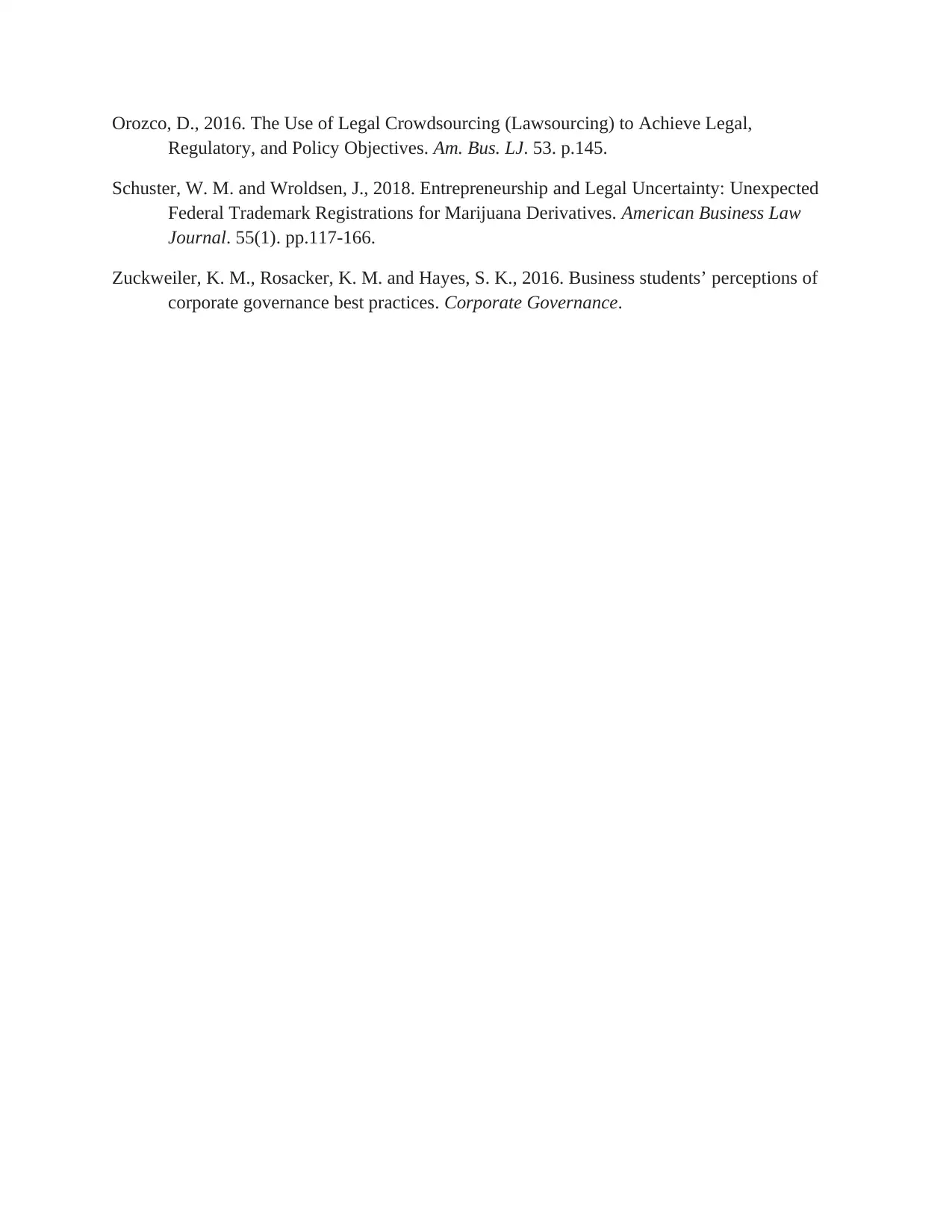
Orozco, D., 2016. The Use of Legal Crowdsourcing (Lawsourcing) to Achieve Legal,
Regulatory, and Policy Objectives. Am. Bus. LJ. 53. p.145.
Schuster, W. M. and Wroldsen, J., 2018. Entrepreneurship and Legal Uncertainty: Unexpected
Federal Trademark Registrations for Marijuana Derivatives. American Business Law
Journal. 55(1). pp.117-166.
Zuckweiler, K. M., Rosacker, K. M. and Hayes, S. K., 2016. Business students’ perceptions of
corporate governance best practices. Corporate Governance.
Regulatory, and Policy Objectives. Am. Bus. LJ. 53. p.145.
Schuster, W. M. and Wroldsen, J., 2018. Entrepreneurship and Legal Uncertainty: Unexpected
Federal Trademark Registrations for Marijuana Derivatives. American Business Law
Journal. 55(1). pp.117-166.
Zuckweiler, K. M., Rosacker, K. M. and Hayes, S. K., 2016. Business students’ perceptions of
corporate governance best practices. Corporate Governance.
1 out of 11
Related Documents
Your All-in-One AI-Powered Toolkit for Academic Success.
+13062052269
info@desklib.com
Available 24*7 on WhatsApp / Email
![[object Object]](/_next/static/media/star-bottom.7253800d.svg)
Unlock your academic potential
Copyright © 2020–2025 A2Z Services. All Rights Reserved. Developed and managed by ZUCOL.





